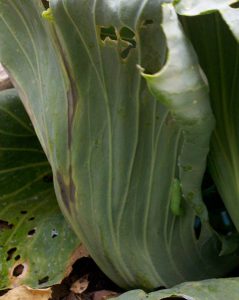 Use your problem solving skills in the garden. Here are a few potential problems you might encounter with your cabbage and how to solve them. You can learn more on the How to Grow Cabbage page of the Bonnie Plants website.
Use your problem solving skills in the garden. Here are a few potential problems you might encounter with your cabbage and how to solve them. You can learn more on the How to Grow Cabbage page of the Bonnie Plants website.
Cracking and Splitting
If you leave your cabbage in the garden after the head has formed and it rains, the head may crack or split. If this happens, an adult should harvest the cabbage right away.
Patrol for insects pests and worms
If you see holes in cabbage leaves or moths flying around your cabbage it’s likely that something is eating your cabbage! Scout often and diligently for insect pests or cabbage worms around the plant and on the underside of the big leaves, where they like to hide. The moths you might see, come from worms, which will eat your cabbage.
Rid your cabbage of pesky insects and worms, asap!
Ask an adult to help remove any insects or worms you find on your cabbage. Worms can be hand-picked from leaves and dropped in a bucket of soapy water. Insects can be dislodged by water jetting them with a constant jet-stream of water from a hose, or you can use a horticultural soap or oil, like Neem Oil, to rid your cabbage of pesky insects. Be sure an adult helps you with the process.
Wilted and Yellow Leaves
Yellow leaves could mean many things, from overwatering to Clubroot, a common disease that affects cabbage. The most obvious symptoms of clubroot are yellowing, wilting leaves. Avoid this problem by keeping your plant healthy and your garden free of insect pests, weeds and debris. Also, don’t plant cabbages or other related veggies (such as broccoli, kale, or collards) in the same spot year after year.
Bolting and flowering
If your cabbage sends up a flower stalk instead of forming a head, it’s called bolting. Bolting usually occurs in cabbage when temperatures get too hot. When the ground temperature goes above a certain temperature, the plant will produce flowers and seeds very rapidly and abandon leaf growth, trying to quickly produce the next generation of seed. Once a cabbage plant bolts, a head will not form — but you can still eat the leaves! Harvest them as soon as possible, or they’ll start to taste bitter.
